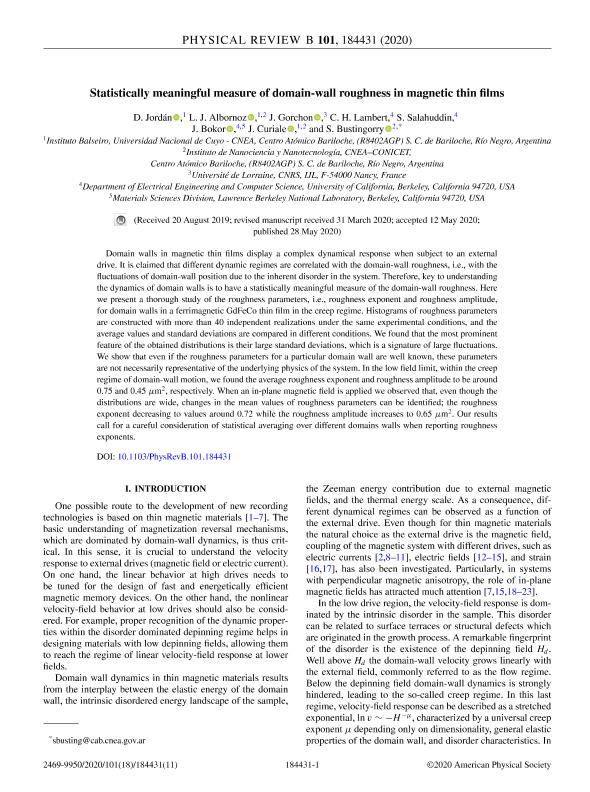Mostrar el registro sencillo del ítem
dc.contributor.author
Jordán Ringgold, Daniel

dc.contributor.author
Albornoz, Lucas Javier

dc.contributor.author
Gorchon, Jon
dc.contributor.author
Lambert, Charles Henri
dc.contributor.author
Salahuddin, Sayeef
dc.contributor.author
Bokor, Jeffrey
dc.contributor.author
Curiale, Carlos Javier

dc.contributor.author
Bustingorry, Sebastian

dc.date.available
2021-11-11T12:19:49Z
dc.date.issued
2020-05
dc.identifier.citation
Jordán Ringgold, Daniel; Albornoz, Lucas Javier; Gorchon, Jon; Lambert, Charles Henri; Salahuddin, Sayeef; et al.; Statistically meaningful measure of domain-wall roughness in magnetic thin films; American Physical Society; Physical Review B; 101; 18; 5-2020; 1-11
dc.identifier.issn
2469-9950
dc.identifier.uri
http://hdl.handle.net/11336/146663
dc.description.abstract
Domain walls in magnetic thin films display a complex dynamical response when subject to an external drive. It is claimed that different dynamic regimes are correlated with the domain-wall roughness, i.e., with the fluctuations of domain-wall position due to the inherent disorder in the system. Therefore, key to understanding the dynamics of domain walls is to have a statistically meaningful measure of the domain-wall roughness. Here we present a thorough study of the roughness parameters, i.e., roughness exponent and roughness amplitude, for domain walls in a ferrimagnetic GdFeCo thin film in the creep regime. Histograms of roughness parameters are constructed with more than 40 independent realizations under the same experimental conditions, and the average values and standard deviations are compared in different conditions. We found that the most prominent feature of the obtained distributions is their large standard deviations, which is a signature of large fluctuations. We show that even if the roughness parameters for a particular domain wall are well known, these parameters are not necessarily representative of the underlying physics of the system. In the low field limit, within the creep regime of domain-wall motion, we found the average roughness exponent and roughness amplitude to be around 0.75 and 0.45 μm2, respectively. When an in-plane magnetic field is applied we observed that, even though the distributions are wide, changes in the mean values of roughness parameters can be identified; the roughness exponent decreasing to values around 0.72 while the roughness amplitude increases to 0.65 μm2. Our results call for a careful consideration of statistical averaging over different domains walls when reporting roughness exponents.
dc.format
application/pdf
dc.language.iso
eng
dc.publisher
American Physical Society

dc.rights
info:eu-repo/semantics/openAccess
dc.rights.uri
https://creativecommons.org/licenses/by-nc-sa/2.5/ar/
dc.subject
DOMAIN WALL
dc.subject
ROUGHNESS
dc.subject
MAGNETISM
dc.subject
THIN FILMS
dc.subject.classification
Física de los Materiales Condensados

dc.subject.classification
Ciencias Físicas

dc.subject.classification
CIENCIAS NATURALES Y EXACTAS

dc.subject.classification
Nano-materiales

dc.subject.classification
Nanotecnología

dc.subject.classification
INGENIERÍAS Y TECNOLOGÍAS

dc.title
Statistically meaningful measure of domain-wall roughness in magnetic thin films
dc.type
info:eu-repo/semantics/article
dc.type
info:ar-repo/semantics/artículo
dc.type
info:eu-repo/semantics/publishedVersion
dc.date.updated
2021-04-28T21:57:54Z
dc.identifier.eissn
2469-9969
dc.journal.volume
101
dc.journal.number
18
dc.journal.pagination
1-11
dc.journal.pais
Estados Unidos

dc.description.fil
Fil: Jordán Ringgold, Daniel. Comisión Nacional de Energía Atómica. Gerencia del Área de Energía Nuclear. Instituto Balseiro. Archivo Histórico del Centro Atómico Bariloche e Instituto Balseiro | Universidad Nacional de Cuyo. Instituto Balseiro. Archivo Histórico del Centro Atómico Bariloche e Instituto Balseiro; Argentina
dc.description.fil
Fil: Albornoz, Lucas Javier. Consejo Nacional de Investigaciones Científicas y Técnicas. Oficina de Coordinación Administrativa Ciudad Universitaria. Unidad Ejecutora Instituto de Nanociencia y Nanotecnología. Unidad Ejecutora Instituto de Nanociencia y Nanotecnología - Nodo Bariloche | Comisión Nacional de Energía Atómica. Unidad Ejecutora Instituto de Nanociencia y Nanotecnología. Unidad Ejecutora Instituto de Nanociencia y Nanotecnología - Nodo Bariloche; Argentina
dc.description.fil
Fil: Gorchon, Jon. Lawrence Berkeley National Laboratory; Estados Unidos
dc.description.fil
Fil: Lambert, Charles Henri. University of California at Berkeley; Estados Unidos
dc.description.fil
Fil: Salahuddin, Sayeef. University of California at Berkeley; Estados Unidos
dc.description.fil
Fil: Bokor, Jeffrey. University of California at Berkeley; Estados Unidos. Lawrence Berkeley National Laboratory; Estados Unidos
dc.description.fil
Fil: Curiale, Carlos Javier. Consejo Nacional de Investigaciones Científicas y Técnicas. Oficina de Coordinación Administrativa Ciudad Universitaria. Unidad Ejecutora Instituto de Nanociencia y Nanotecnología. Unidad Ejecutora Instituto de Nanociencia y Nanotecnología - Nodo Bariloche | Comisión Nacional de Energía Atómica. Unidad Ejecutora Instituto de Nanociencia y Nanotecnología. Unidad Ejecutora Instituto de Nanociencia y Nanotecnología - Nodo Bariloche; Argentina
dc.description.fil
Fil: Bustingorry, Sebastian. Consejo Nacional de Investigaciones Científicas y Técnicas. Oficina de Coordinación Administrativa Ciudad Universitaria. Unidad Ejecutora Instituto de Nanociencia y Nanotecnología. Unidad Ejecutora Instituto de Nanociencia y Nanotecnología - Nodo Bariloche | Comisión Nacional de Energía Atómica. Unidad Ejecutora Instituto de Nanociencia y Nanotecnología. Unidad Ejecutora Instituto de Nanociencia y Nanotecnología - Nodo Bariloche; Argentina
dc.journal.title
Physical Review B
dc.relation.alternativeid
info:eu-repo/semantics/altIdentifier/url/https://link.aps.org/doi/10.1103/PhysRevB.101.184431
dc.relation.alternativeid
info:eu-repo/semantics/altIdentifier/doi/http://dx.doi.org/10.1103/PhysRevB.101.184431
Archivos asociados
